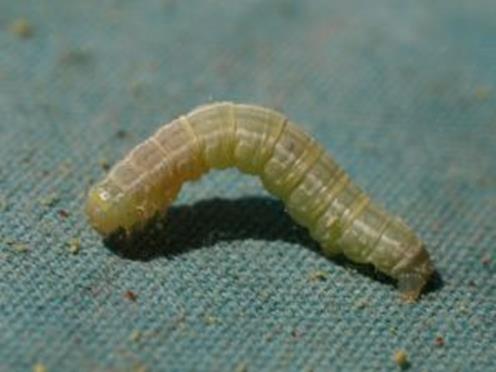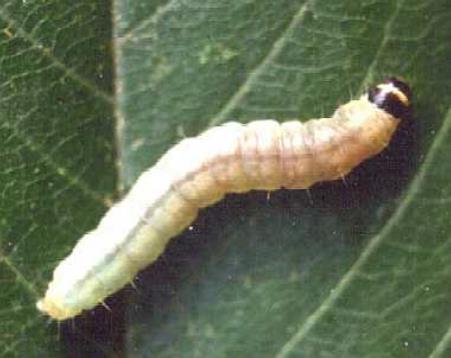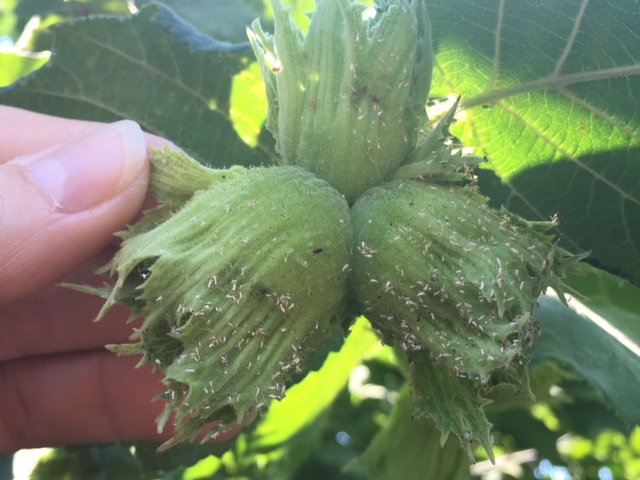Hazelnut Insect Management
Pest management requires regular monitoring of the orchard to determine the presence and severity of pest infestations, and the timely and appropriate management control
Foliage Feeding Caterpillars
|
Bruce Spanworm |
Leafroller |
Status in BC: Many species, most common in BC include Bruce spanworm, Winter moth, European/Filbert leafroller and oblique banded leafroller.
Damage: Many species of fruit and nut trees, native trees and shrubs including willow, poplar, maple and alder are hosts of the various species of leafrollers and spanworms. Bud damage can occur in early spring, as well as leaf damage in spring and summer. Severe infestations can almost defoliate small trees.
Biology: Bruce spanworm and winter moth adults fly in October and November, mate and lay overwintering eggs, laid singly on twigs in early winter. Eggs hatch in March and caterpillars feed on green tissue until dropping to the soil in late May where pupation occurs. Larvae and pupae remain in the soil until late fall and winter (October-December), when adults emerge.
Leafroller life cycles vary between species, but most species overwinter as larvae or eggs, hatching and/or becoming active and feeding in the spring, when green tissue first appears. The larvae feed on leaves and buds. Leaf-rolling caterpillars will roll leaves up as they expand, using silken webbing, where they hide during the day. European or Filbert leafroller has one generation per year, with moth flight occurring in early summer (approximately June). Oblique banded leafroller has two generations per year, so can cause damage to foliage and buds in both spring and mid summer.
Monitoring: Visually examine buds and leaves for presence of larvae and feeding damage. Limb taps can also detect larvae. Some species, including the European/filbert leafroller and oblique banded leafroller, can be monitored for moth flight using pheromone baited traps in summer, to estimate population and timing of flight.
Management: Insecticides (organic and conventional) are registered for use in tree nuts for caterpillar control. Normally in BC foliage feeding caterpillars do not reach high enough levels to warrant spraying in established large trees. However, it may be necessary in smaller trees that are not yet fully established. Additionally, naturally occurring predators and parasites of leafrollers and other caterpillars are widely present in BC and will help manage these pests.
British Columbia
- https://www2.gov.bc.ca/assets/gov/farming-natural-resources-and-industry/agriculture-and-seafood/animal-and-crops/plant-health/phu-bruce-spanworm.pdf
- https://tidcf.nrcan.gc.ca/en/insects/factsheet/1000088
- https://www2.gov.bc.ca/assets/gov/farming-natural-resources-and-industry/agriculture-and-seafood/animal-and-crops/plant-health/phu-tree-fruit-leafrollers.pdf
Ontario
- http://www.omafra.gov.on.ca/english/crops/facts/12-009.htm
- http://www.omafra.gov.on.ca/english/crops/facts/12-009.htm
Oregon
Aphids
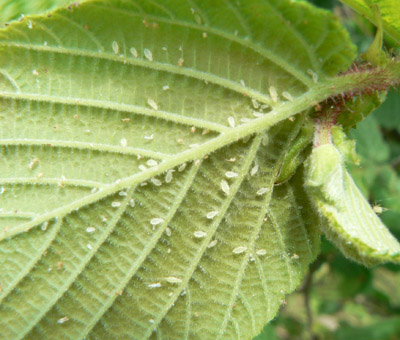 Aphids on the underside of a hazelnut leaf |
|
Status in BC: Present
Aphids can be found on the underside of hazelnut leaves and husks. There are two main aphid species of concern in hazelnuts: the filbert aphid, Myzocallis coryli,and, the hazelnut aphid, Corylobium avellanae.
Damage: Aphids suck fluids from plant cells, causing yellowing, wilting, and distortion of leaves. Honeydew is produces as excrement, which causes the growth of black sooty mould on the surface of leaves.
Biology: The filbert aphid overwinters as an egg in crevices on bark and around bud scales. Eggs hatch in the spring, and the young aphids feed on the underside of expanding leaves. Aphids mature rapidly and give birth to live offspring allowing for large population increases in summer.
Colonies form on the undersides of leaves, with all growth stages present. There are several generations each summer. Aphid populations can increase quickly and decline in late summer due to high heat and increased activity by natural enemies. In late summer and fall, aphids mate and lay overwintering eggs.
Identification and Monitoring: Aphids are small and green and may be winged or wingless. Monitor weekly or bi-weekly for aphids in spring on the underside of new leaves. Keep a record of the numbers found and how they change over the season. Also record any predators and ‘mummies’ (parasitized aphids) you find.
Management: Excess nitrogen can encourage aphid activity; ensure fertilizer applications are suitable. Many species of predators and parasites of aphids are present in BC and help to keep these pests under control, particularly in mid and late summer. Insecticides are available for aphids, but are not normally needed in BC hazelnut orchards.
Scale
Status in BC: Various species present, but not a reported production issue in BC hazelnut orchards
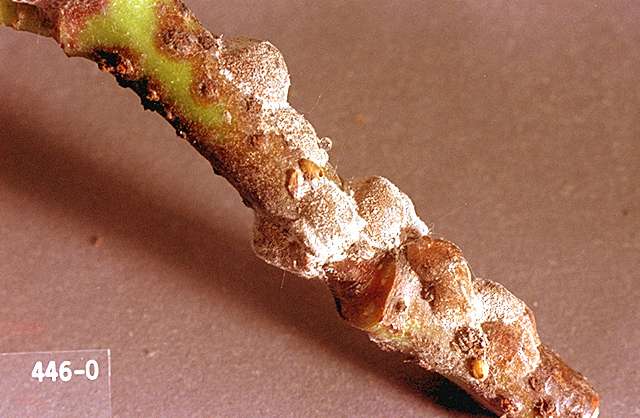
Scale insects on a hazelnut branch
Damage: Scale insects have piercing-sucking mouthparts, used to suck plant fluids, which can cause unthriftiness and even death of small branches if populations are high enough. Scales produce large amounts of honeydew as excrement, which hosts the growth of black sooty mould which can further impact plant health resulting in unthriftiness.
Biology: Scales are tiny insects that become immobile by attaching to plants and sucking plant fluids. Scale nymphs can be small, flat, oval and mobile when they are young, and walk readily on the plant surfaces. At this mobile stage, they are called ‘crawlers’ and can disperse to new plants via wind, rain, irrigation, or by the movement of people and machinery. As crawlers age, they settle on the plant surface, insert their straw-like mouth, and suck plant fluids. Once settled, the scale insect no longer moves, and feeds until a scale forms, and eggs are produced under it, resulting in a new crop of crawlers.
A common type of scale is the lecanium scale (Parthenolecanium spp.). The ‘scales’ of this species looks like tiny bulbous turtle shells on twig and branch surfaces. Lecanium scale overwinters as an immature scale on twigs and branches. They resume feeding in the spring, become adult females with ‘shells’ and lay eggs underneath in May to June. Eggs hatch in early summer into crawlers which migrate to the undersides of leaves to feed. After 4 to 6 weeks on the leaves, the young return to the stems and twigs to feed, mate, and overwinter. There is one generation per year.
Identification and Monitoring: Scout the orchard for scales by visually inspecting stems and twigs for the bump-like scales in spring and early summer. If scales are found, dislodge some a look for eggs and crawlers. Record your findings. If none are seen, check again in one week. Double sided tape or other adhesive or glue can be used as a trap by applying or wrapping around a few branches and then watching for crawlers to get stuck. You will need a hand lens to accurately identify presence of crawlers.
Management: Scale can be rubbed off plants by hand with a glove or toothbrush. Major infestations can be pruned off. As with aphids, avoid excessive nitrogen fertilizer or water applications, as this may encourage population increases. Late winter applications of dormant oil will help to suppress overwintering scales. Applications of summer oil or other registered insecticide at the crawler stage will help control populations. There are many parasitoids and predators of scale insects in BC, and these generally keep pest scale populations in check.'
Oregon
Filbertworm
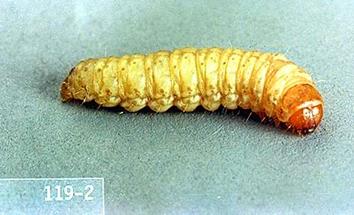 Filbertworm Larvae |
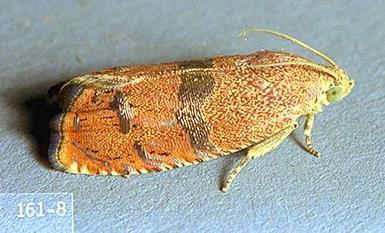 Adult filbertworm moth |
Status in BC: Present, but not usually a pest issue in BC hazelnut crops
Damage: The larvae feed on the kernels, severely reducing nut quality and marketable yield.
Biology: The filbertworm, Cydia latiferreana, is a caterpillar that feeds in nuts of hazelnuts and oaks. It is a serious pest in most hazelnut-producing regions of the world. Adult moths are gray to reddish with golden bands across each forewing. After mating in the spring, female moths lay single eggs near developing nuts from June through until fall. After 8-10 days, eggs hatch and larvae enter a nut to feed, where they remain for up to 4 weeks until they are about 1 cm long. Larvae are whitish with a brown head. Exit holes in nuts bored by the larvae are evident in harvested nuts, as well as frass and webbing. Larvae overwinter on the orchard floor under leaves and other debris, about 2-5 cm deep, in a cocoon. In the spring, the larvae pupate and the moths emerge. There is one generation per year.
Identification and Monitoring: Adults of this insect can be monitored with commercially available pheromone traps to help determine if the adults are present, if their numbers are sufficient to cause significant damage and when to expect larval presence. Traps may be ideally placed close to wild hazelnut or oak, and set up by mid-May before the moths begin to fly. Suggested trap density: use four traps for the first 10 acres and one for each additional 4 acres. For smaller orchards, 1-2 traps are adequate. Place the traps in the upper third of the canopy if possible. The action threshold is 2-3 moths per trap or five moths in any one trap.
Management: There are limited insecticides available for this pest. Insecticides sprays applied for other pests such as leafrollers will help to control filbertworm if present. Optimal treatment time is in mid-July to mid-August.
Oregon
Ontario
Brown Marmorated Stink Bug
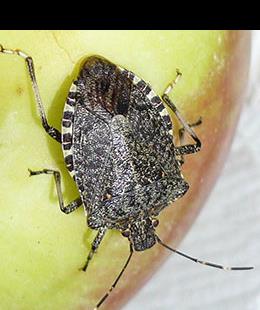 Adult brown marmorated stink bug |
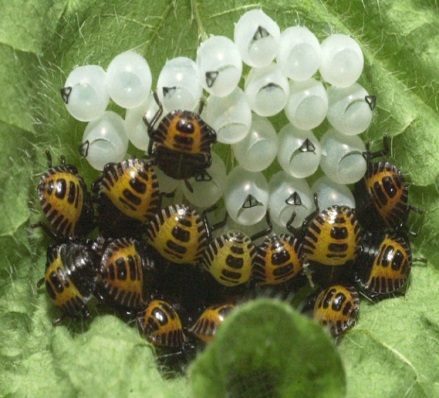 First instar nymphs with egg mass |
Status in BC: Brown marmorated stink bug (BMSB) is a recently established pest in BC, first detected in 2015 in the Fraser Valley and Okanagan. Present in urban areas as determined by survey and public reports. Not yet known to occur in agriculture crops or hazelnuts.
Damage: Both BMSB adults and nymphs feed by inserting their mouthparts into the flesh of fruit or vegetables. Feeding punctures result in small dead areas on fruit, vegetables and leaves. It can feed on over 100 different plant species, and is known to damage the nuts during development in Oregon hazelnut orchards, causing distortion, decreasing marketability and quality.
Biology: Adult bugs are large (13 – 17 mm long) shield shaped brown stink bugs with white banding on legs and antennae. Adults may be confused with other native brown stink bugs and western conifer seed bugs. Eggs are laid in June in clusters of 20-30 white round eggs, about 1 mm in diameter, on the underside of host plant leaves. Nymphs hatch in early summer, and feed on plants. Initially, nymphs are orange and black, but as they grow they become mostly black with white bands on legs and antennae. Both nymphs and adults can be found together, and prefer the same hosts. All are very mobile, and will readily run or fly when disturbed. By late summer and fall, most of the population are adults, but some nymphs also appear to overwinter in BC. They aggregate in protected areas, like homes and buildings, becoming a nuisance when they accidentally are found indoors. There is one generation per year.
Identification and Monitoring: Traps and lures are commercially available and can be helpful in identifying the presence of BMSB in the area. However, the efficacy of the traps is highly variable and some are unreliable. Regular visual field scouting for presence of bugs and potential damage is useful for determining presence.
Management: Predators such as spiders, ladybugs and lacewings will feed on brown marmorated stink bug eggs. An egg parasitoid, Trissolcus japonicus, which is very effective in controlling BMSB was recently established in the USA. Native North American egg parasitoids of stink bugs are less effective on BMSB. There are initiatives underway to bring the new parasitoid to Canada to help control BMSB. Use of insecticides for control of BMSB has been challenging, as the bugs are highly mobile and they move from host to host in an unpredictable manner.
Bud Mites
Status in BC: Possibly present in BC, but no reported occurrences in hazelnut orchards.
Damage: Bud mites feed within flower and leaf buds, causing buds to swell into oversized ‘big buds’, or blasted buds. These damaged buds dry up and fall off, and mites move to new buds. Buds may open or partially open, but will be distorted, rigid, and brittle and catkins produce little or no pollen. Hazelnut varieties differ in susceptibility to bud mite infestation.
Biology: Two species cause bud damage: Phytoptus or Phytocoptella avellanae (the filbert bud mite), the most harmful, and Cecidophyopsis vermiformis. Both species may be found in the same bud. Mites overwinter within the buds. In summer they move from old buds to newly formed buds and cause them to expand from late summer through winter. Mites are protected within buds most of the time.
Identification and Monitoring: Filbert bud mites are nearly translucent, cigar-shaped, microscopic organisms. They cannot be seen with the naked eye but can be detected by the damage they cause. Monitoring can be done by searching for big buds, and dissecting suspect buds to confirm presence of mites.
Management: When big buds and damage is present, begin management which includes pruning and destroying infested buds where possible.
At least two applications of sulphur or lime sulphur sprays in late winter and spring will kill exposed mites as they move from old buds to new buds. Predatory mites may help control these pest mites.
True Bug: Phylus coryli
Status in BC: present in hazelnut orchards
Damage: This true bug is omnivorous. It does feed on hazelnut leaves and this can be seen readily on the leaves throughout the season. Pylus coryli is also a predator of aphids.
Biology: Pylus coryli is native to Europe, but is now common in south west BC. It has at least two generations per year in BC, and either the black adults with yellow legs or the yellow nymphs can be seen throughout the season.
No management is expected to be needed for this insect.
Leafhoppers
Status in BC: Present in hazelnut orchards
Damage: Leafhoppers are widely present in BC, and several species feed on many species of plants and crops, causing characteristic speckling on leaves from adult and nymphs feeding. Leafhoppers feed by piercing plant cells and sucking the fluids out.
Biology: Depending on the species, leafhoppers may overwinter as adults or eggs. Populations increase through summer, and may have 2 or more generations per year. Adults are winged, nymphs are highly mobile. Both are easily disturbed and fly or disperse readily, making it difficult to visually identify the insects in the field, or catch for further examination.
Management: May be justified in small trees if nymph populations are high and extensive speckling is evident on hazelnut leaves. Some natural biocontrol may occur, but this does not always provide adequate control.
General Hazelnut Production and Pest Management References:
For more information see BCAGRI Production Guide Supporting Documents.
Find downloadable supporting documents featuring: Metric Tables, Pesticide Regulations and Safety, Sprayer Calibration, and Sprayer Equipment
Pesticides in Agriculture
Integrated Pest Management

